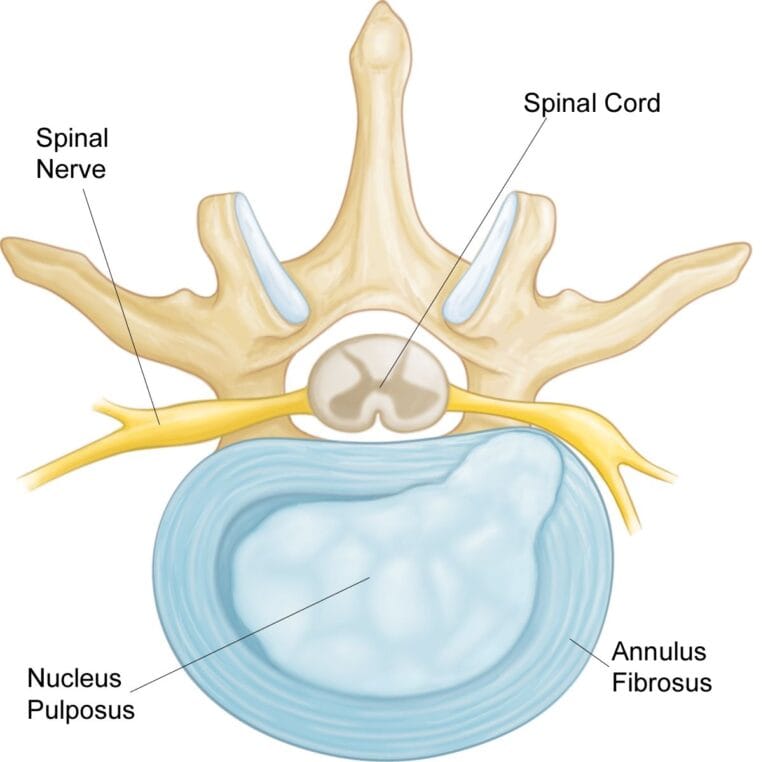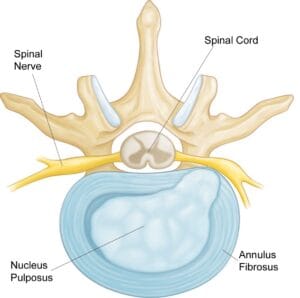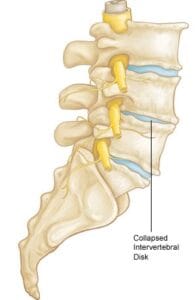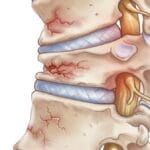Low back pain is a common issue that affects nearly everyone at some point in their lives, with symptoms ranging from mild discomfort to severe pain. This condition can be temporary or persistent, yet regardless of its duration, low back pain often hinders daily activities and limits mobility.
Anatomy of the Spine
The spine consists of a series of small bones known as vertebrae, which are stacked vertically to form the spinal column. In addition to these vertebrae, muscles, ligaments, nerves, and intervertebral discs play essential roles in spine function.
Muscles and ligaments work to stabilize the vertebrae, while intervertebral discs act as “shock absorbers” for the spine, allowing it to withstand various movements and stresses. Nerves within the spine enable vital communication between the brain and the body.
A foundational understanding of spinal anatomy can provide insight into the origins and nature of low back pain. Discover more about spinal structure in Spine Basics.
Understanding Back Pain
Back pain manifests differently for everyone. Some may experience a gradual onset, while others may encounter sudden pain. For some, the discomfort is periodic; for others, it’s constant. In most cases, back pain will naturally subside within a few weeks.
Causes of Low Back Pain
Low back pain can arise from many sources, often following certain movements like lifting or bending. Aging is also a significant factor in back health.
As we age, our spine undergoes degenerative changes that can start as early as our 30s—or even younger—leading to an increased susceptibility to back pain, particularly with strenuous activity.
However, these age-related spinal changes rarely prevent people from living active and relatively pain-free lives. Many older adults, including septuagenarian marathon runners, continue to thrive despite age-related spinal degeneration.
Overactivity and Low Back Pain
A frequent cause of low back pain is muscle soreness resulting from overactivity. When muscles and ligament fibers are overstretched or strained, they can become sore or even injured.
This type of discomfort often occurs after the first intense activity of the season—such as playing softball, golfing, doing extensive yard work, or shoveling snow. Many people experience this familiar stiffness and soreness in the lower back and other body areas, which generally subsides within a few days.
Disk Injuries and Persistent Low Back Pain
In some cases, low back pain doesn’t resolve within a few days, which may indicate an injury to an intervertebral disk.
Disk Tear: Small tears in the outer layer of the disk, known as the annulus, can develop over time, especially as we age. While some individuals with disk tears experience no pain, others may suffer from discomfort that persists for weeks, months, or even years. A small percentage may endure constant, debilitating pain. The reasons why some individuals feel pain while others don’t remain unclear.
Disk Herniation: Another prevalent disk injury is known as a “slipped” or herniated disk.
Understanding Disk Herniation and Its Impact on Nerve Pain
A disk herniates when its soft, jelly-like center (the nucleus) pushes outward against the annulus. If the disk becomes worn or damaged, the nucleus may protrude fully through the annulus. When a herniated disk presses against the spinal canal, it can put pressure on sensitive spinal nerves, leading to significant pain.
In the lower back, a herniated disk often compresses the nerve root that extends to the leg and foot, resulting in pain that radiates from the buttock down the leg—a condition known as sciatica.
Herniated disks commonly occur from activities involving lifting, pulling, bending, or twisting motions.
Herniated disk.
Disk Degeneration and Age-Related Back Pain
As we age, intervertebral disks naturally begin to wear down and shrink. In some cases, the disks may collapse entirely, causing the facet joints—the small joints between each vertebra at the back of the spine—to rub against each other, leading to pain and stiffness. Smoking has also been shown to speed up disk degeneration.
This wear and tear on the facet joints, known as osteoarthritis or spondylosis, can contribute to additional back issues, including spinal stenosis.
Disk degeneration
Degenerative Spondylolisthesis: Age-Related Vertebrae Slippage
Degenerative spondylolisthesis (pronounced spon-dee-low-lis-THEE-sis) occurs as a result of aging and natural wear and tear, which weaken the joints and ligaments that support spinal alignment. This condition allows the vertebrae to move excessively, sometimes causing one vertebra to slip forward over another. When this slippage becomes significant, it can place pressure on the spinal nerves, leading to discomfort and other symptoms.
Spondylolisthesis.
Spinal Stenosis
Spinal stenosis develops when the space surrounding the spinal cord narrows, putting pressure on both the spinal cord and nearby nerves.
As intervertebral disks deteriorate and osteoarthritis forms, the body may respond by forming new bone in the facet joints to help support the vertebrae. This bone growth, known as bone spurs, can gradually narrow the spinal canal. Additionally, osteoarthritis can cause ligaments connecting the vertebrae to thicken, further constricting the spinal canal.
Scoliosis
Scoliosis is an abnormal curvature of the spine that typically develops in children, most often during adolescence, but can also occur in older adults due to arthritis. This spinal irregularity can cause back pain, and if nerves are compressed, it may lead to pain, weakness, or numbness in the legs.
Compression Fracture
Vertebral compression fractures are a frequent source of back pain in older adults. With aging, bones tend to weaken, making them more prone to fractures—a condition known as osteoporosis. For individuals with osteoporosis, even minor impacts, such as sitting down forcefully or a low-level fall, can cause spinal fractures, leading to intense pain with movement.
Additional Causes
Various other conditions can also cause back pain, some of which are more serious. Individuals with vascular or arterial disease, a history of cancer, or pain that persists regardless of activity or position should consult their primary care provider.
Symptoms of Back Pain
Back pain symptoms can vary widely. Some may feel sharp or stabbing pain, while others experience a dull ache or cramping sensation. The type and intensity of pain typically depend on its cause.
Most people with back pain find relief when lying down. However, pain can intensify during:
- Bending and lifting
- Sitting
- Standing and walking
Common symptoms associated with low back pain include:
- Back pain that fluctuates, with good days and bad days.
- Pain that radiates to the buttock or outer hip area but does not extend down the leg.
- Sciatica, where pain, numbness, tingling, or weakness travels from the buttock down the leg to the foot. Sciatica often results from a herniated disk, though it can occur without back pain.
Regardless of age, if back pain does not improve within a few weeks or is accompanied by fever, chills, or unintentional weight loss, it is essential to consult a doctor. Other concerning symptoms include leg weakness and loss of bladder or bowel control.
Tests and Diagnosis
Medical History and Physical Examination
Your doctor will begin by reviewing your symptoms and medical history, followed by a physical examination of your back. This includes observing your back, pressing on various areas to assess tenderness, and asking you to move in different directions to identify pain or limitations.
Your doctor may also evaluate nerve function in your legs by testing reflexes at the knees and ankles, as well as checking strength and sensation. This can indicate the severity of any nerve involvement.
Imaging Tests
To help confirm a diagnosis, your doctor may order imaging tests, including:
- X-rays: While X-rays primarily show bones, they can reveal obvious causes of back pain such as fractures, degeneration, or spinal deformities. However, X-rays do not capture soft tissues like disks, muscles, or nerves.
- Magnetic Resonance Imaging (MRI): MRI scans provide detailed images of soft tissues, making them useful for identifying conditions like herniated disks or infections that may not be visible on X-rays.
- Computerized Axial Tomography (CAT) Scan: If a bone issue is suspected, your doctor may recommend a CAT scan. This test produces a three-dimensional view of bones.
- Bone Scan: In cases where additional information is needed to rule out rare causes like cancer or infection, a bone scan can provide valuable insights and help detect fractures.
- Bone Density Test: If osteoporosis is a concern, a bone density test can assess bone strength. While osteoporosis itself does not cause back pain, fractures resulting from weakened bones can.
Treatment Options for Low Back Pain
In general, low back pain treatments fall into three main categories: medication, physical therapy, and surgery.
Nonsurgical Treatments
Medications: Several types of medication can help alleviate pain.
- Acetaminophen provides pain relief with minimal side effects.
- Non-steroidal anti-inflammatory drugs (NSAIDs), such as aspirin, ibuprofen, and naproxen, reduce pain and inflammation.
- Steroids, taken orally or injected into the spine, deliver a potent anti-inflammatory effect.
- Muscle relaxants like methocarbamol, carisoprodol, and cyclobenzaprine may also be effective, though they can cause drowsiness. Avoid driving or activities requiring alertness when using muscle relaxants.
Physical Therapy and Alternative Therapies: Combining medications with physical therapy can often help restore mobility and ease pain, making everyday activities more manageable.
- Physical therapy may involve passive treatments like heat, ice, massage, ultrasound, and electrical stimulation, as well as active exercises for stretching, strength-building, and cardiovascular health.
- Back braces, particularly corset-style braces, may provide stability and comfort for some.
- Chiropractic and manipulation therapies can offer relief for some patients.
- Traction therapy is sometimes used but lacks strong scientific support.
- Exercise programs such as Pilates or yoga can also benefit certain patients.
Surgical Treatments
Surgery is generally considered only after nonsurgical options have been attempted for 6 to 12 months without success, and when the exact source of pain has been identified.
- Spinal Fusion: This procedure involves “fusing” two vertebrae together to prevent motion that may be causing pain. This technique is often recommended for spinal instability, scoliosis, or severe disk degeneration. During the procedure, bone grafts and sometimes screws, rods, or cages are used to stabilize the spine until the vertebrae fuse. Recovery may take over a year, and outcomes vary widely.
- Disk Replacement: In this procedure, a damaged disk is replaced with an artificial one, aiming to maintain some spinal flexibility and more natural motion. While not new, the effectiveness of artificial disk replacement compared to spinal fusion remains debated.
- Diskectomy: A diskectomy involves removing the damaged portion of a herniated disk, which helps relieve nerve pressure and resolve sciatica.
- Laminectomy: This procedure removes thickened ligaments and bone spurs that are compressing nerves, helping to alleviate spinal canal pressure and reduce nerve pain.
- Kyphoplasty/Vertebroplasty: To stabilize an osteoporotic compression fracture, cement is injected into the fractured bone, reducing the sharp pain associated with the injury.
Preventing Low Back Pain
Though aging and wear on the spine are unavoidable, certain lifestyle practices can help minimize the impact of low back issues.
- Exercise Regularly: Engage in aerobic activities like walking or swimming, paired with exercises to strengthen and stretch your back and abdominal muscles.
- Use Proper Lifting Techniques: Lift heavy objects using your legs, not your back. Keep your back straight and bend at the knees rather than bending over.
- Maintain a Healthy Weight: Extra weight puts additional strain on the lower back.
- Avoid Smoking: Both smoke and nicotine accelerate spine aging. If you smoke, consider quitting.
- Practice Good Posture: Proper posture helps prevent future problems. A therapist can teach safe techniques for standing, sitting, and lifting.








